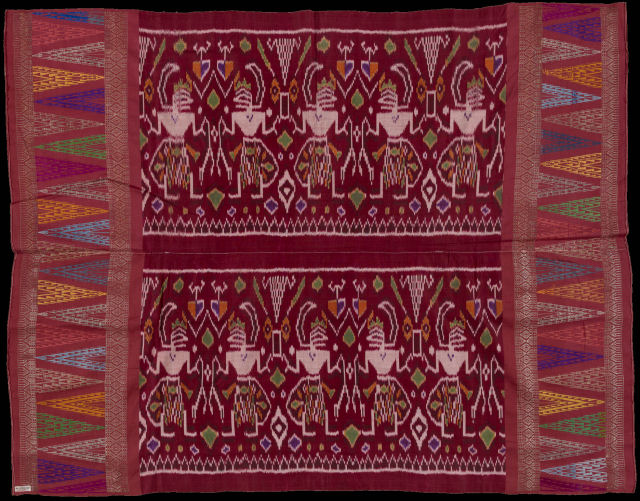Bali, the island of sacred consciousnessOn Bali, the sacral is very much part of the quotidian. Many hours of the week are spent to devotion at home altars, venerating ancestors and gods, devotion to the rice goddesses in the fields, attending ceremonies and preparing for ceremonies. All life cycle events are occasions for holding ceremonies, often very elaborate, and all requiring certain textiles, ikated cloths always prominent among them.Endek, weft ikat - from royal to popularBalinese society is still shaped by its Hindu caste system, though over the last decades the stratifications have become much less rigid. This is reflected in the textile production of the island. Traditionally the Balinese endek (weft ikat) cloths were reserved for the nobility. Produced predominantly in Buleleng, the northern coastal strip, they tended to be made of silk, and were often decorated with songket in gold or silver. The dyes used were mainly varying shades of red between brick and burgundy, with occasional touches of an ochre-like yellow and a mute green, and the motifs were predominantly geometric. Where figurative designs were used, they were mostly imitations of the patola parade motif, with elephants, tigers and other animals - a substitute for the real thing, but still highly valued, and emblematic of power, both worldly and spiritual. Other endek cloths from this early period imitate Tenganan geringsing, rich in associations of spiritual power, especially protective magic. Early 20th C. overskirt or kampu. Silk weft ikat, endek, synthetic dyes. Collection Yale University Art Gallery. Ramayana inspired pattern. Photo Christopher Gardner. The 'modern' period began around 1900 when classes other than the nobility began to assume the right to wear endek. Their newly found status, with its concomitant need for confirmation, generated an assertiveness which manifested itself in the choice of attire. The solemn geometric patterns of old lost out to flowers, animals, stars, wayang motifs, and figures from the Ramayana. Natural dyes were replaced by brighter chemical colours, rayon and cotton supplanted silk, and the overall look became more expressive, bolder, sometimes even garish. As early as 1908 Dutch administrators of the Residency Buleleng lamented the introduction of aniline dyes, and the resulting loss of quality in local endek. Over the next decades production fanned out to other parts of Bali - and became a lasting success. Today Balinese endek, while still essentially handwork, is produced on semi-industrial scale, offering employ to over 10,000 people, and exported to all parts of the world, some in the shape of shawls and other ready to wear pieces, most as raw material by the yard for the manufacture of blouses and dresses. The ikat process has been greatly simplified. In many cases, only one dye bath is used; the other colours are tamped in with bamboo sticks. Even so, some traditional endek, using natural dyes only, continued to be made till at least 1950. The best of these 'modern' cloths are rare enough to be considered collectable. For two types of Balinese ikat textiles please refer to their respective dedicated pages:
|


